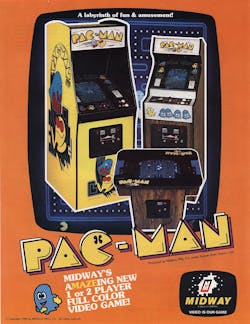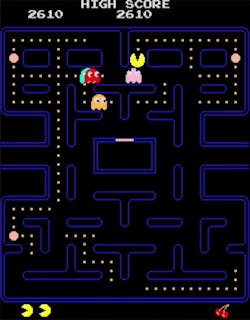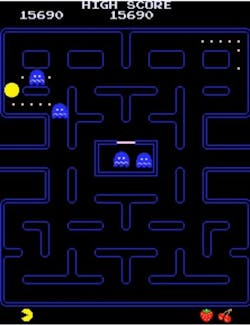Pac-Man: The Revolutionary Video Game Turns 45
What you’ll learn:
- How a young game designer at Namco turned a simple idea about eating into a worldwide gaming icon.
- How each of Pac-Man’s ghosts has its own unique behavior that’s driven by early game logic.
- Why the game still holds up today.
I talk all things Pac-Man in this video.
From 1978 to 1982, you’d be hard-pressed to find a pizza joint, major retail stores, and even laundromats that didn’t have at least one or two arcade games and a swath of kids and teens lining up to dump pockets full of quarters to get a few minutes of gameplay. The craze entered its pinnacle when a record number of companies, including Atari, Nintendo, and Williams Electronics, released some of the most iconic games in history.
The Arrival of Pac-Man from Namco
But one company stood tall among them all, and created the most widely known arcade game in history—Namco’s Pac-Man (Fig. 1). Known as Puck Man in Japan, the game quickly became a worldwide sensation and led to several sequels, merchandise, a pair of television series, and even a hit single, “Pac-Man Fever,” by Buckner & Garcia.
So, what made the game great, and why does it still stand the test of time 45 years after its release? To answer those questions, we have to travel back in time to 1977, where 22-year-old Toru Iwatani began working for Namco (now Bandai Namco).
Originally, Iwatani was interested in designing new pinball games. However, Namco scrapped that idea due to patent issues, but posed another: Why not create a video game based on the concept of pinball? The following year, Iwatani, with help from programmer Shigeichi Ishimura, released Bee Gee, a Breakout-style game that featured some pinball mechanics during gameplay. The video game wasn’t a blockbuster—hell, it wasn’t even in a movie theater!—but it helped Namco get its foot in the door for the video game market.
Toward the end of the 1970s, Iwatani grew tired of the video game industry. He felt that the market was unjustly catered to men, citing examples of “war and sports games,” including Space Invaders and Pong. So, he set out to create a game that would appeal to women, with vibrant colors, great character designs, and, most of all, easy to learn gameplay that was based on the concept of eating.
Pakkuman: The Precusor to Pac-Man
Iwatani began thinking about things women liked to do, and in his mind, women loved to eat sweets and desserts, but who doesn’t? The game he created was titled “Pakkuman,” which is based on the Japanese onomatopoeia term "paku paku taberu,” which references the opening and closing of the mouth.
Pakkuman was the precursor to Pac-Man, which took just about a year and a half to make. To develop the game, Iwatani assembled a team of nine Namco employees, including programmers, a composer, and a hardware engineer. The team took special care to make the game nonviolent, the complete opposite of another popular Namco game in development at the time called Galaxian.
As strange as it may seem, Iwatani took inspiration from the game, noting how bright and vivid the colors were on a new technology at the time, an RGB color display. This allowed him to use sprites instead of colored cellophane strips.
Iwatani was also inspired by Popeye the Sailor, giving him some insight into the development of power-ups within the Pac-Man game. While it’s claimed that he took inspiration from a pizza to design Pac-Man, it’s only half true. The other half was derived from the Japanese "kuchi" character, which translates to “mouth.”
The ghosts were developed using other inspirations, including the Casper the Friendly Ghost cartoon and the manga Obake no Q-Taro. Iwatani thought the ghosts needed to be differentiated, with each having its own distinctive color: Blinky (Red), Pinky (Pink), Inky (Cayenne), and Clyde (Orange). Of course, the fruit bonuses featured in the game were based on slot machine gameplay features that used fruit to denote wins.
Playing Pac-Man
Pac-Man’s gameplay is relatively simple (Fig. 2). Players move Pac-Man around different mazes, trying to eat as many dots as they can, while avoiding the ghosts. But the game’s logic that runs Pac-Man is more complex than we’d expect. Each of the ghosts has its own unique personality (defined by target tiles), which controls their behavior and movement. This was done using a primitive form of AI, if you can call it that.
Each ghost has a specific movement algorithm that makes them behave differently from one another, which was done using deterministic pathfinding based on Pac-Man’s position and direction. Iwatani and his team took advantage of Mode Switching, which enables the ghosts to alternate between “scatter mode and chase mode” every few seconds.
They also utilized ghost-specific targeting logic for those specific tiles mentioned earlier. For example, Blinky targets Pac-Man’s current tile, Pinky targets four tiles ahead of him, and so on.
When eating a power-up dot, the ghosts, again, behave differently, entering into “Frightened Mode” (Fig. 3). This allows the ghosts to scatter and move randomly until the power dot comes to an end, or they get eaten.
Some other interesting insights include: ghosts can only change directions when encountering maze junctions; they can’t reverse direction unless a power-up was eaten; and all of the ghosts, except Clyde, can path-find aggressively using tile-based decision-making and execute an efficient algorithm that plots the shortest course to Pac-Man’s position. A timer is also used to denote the amount of time the ghosts can be eaten before they revert back to their normal mode.
A Look Inside at the Hardware
The hardware used to run the game would be considered paltry by today’s standards, but back in 1979 and 1980, it was cutting-edge. The game was driven by a Zilog Z80 processor (running at 3.072 MHz) and was equipped with 8 kB of character ROM (for graphics like sprites and tiles), 16 kB of game code ROM, and 3 kB of static RAM (1-kB video, 1-kB color, and 1-kB general/program memory).
All graphics were tile-based and rendered at 224 × 288 pixels with hardware sprites in 16 colors. However, the machine didn’t have any frame buffer, which meant all of the sprites were drawn in real-time during horizontal blanking.
Namco’s custom three-channel waveform sound generator (WSG) chip generated the in-game audio, which took advantage of programmable waveforms to create simple, distinct tones. Pac-Man is a level-based game, and unlike games today, players would eventually hit a wall when they reached level 256. The right half (sometimes more) of the screen at this level became corrupted with distorted characters and couldn’t be finished, as it had an integer overflow bug in the 8-bit level counter. This didn’t bother most players, who saw it as a badge of honor and bragging rights.
Pac-Man Legacy
That said, manufacturers found inspiration from Pac-Man’s success in reusing and repurposing arcade hardware for future game titles, capitalizing on efficient game design. Its efficient visual design and programming proved that popular games didn’t need to run on sophisticated hardware.
Pac-Man’s popularity also led to the development and release of an unlicensed mod called “Crazy Otto” in 1981, developed by General Computer Corporation. After Midway’s acquisition, it was released as the infamous Ms. Pac-Man. This mod featured better ghost AI and multiple maze designs, establishing a new standard for future game updates and sequels.
It's been 45 years since Pac-Man was released, and children and adults alike still play the original that Toru Iwatani and his team created long ago. The testament of time can often break old games, sending them into obscurity, or worse, to a long-forgotten landfill in Alamogordo, New Mexico. But for Pac-Man, Iwatani’s creation will continue to entertain gamers for another 45 years and beyond.
Would you like me to do an extreme deep dive into the hardware and software behind Pac-Man? Let me know in the comments below.
About the Author
Cabe Atwell
Technology Editor, Electronic Design
Cabe is a Technology Editor for Electronic Design.
Engineer, Machinist, Maker, Writer. A graduate Electrical Engineer actively plying his expertise in the industry and at his company, Gunhead. When not designing/building, he creates a steady torrent of projects and content in the media world. Many of his projects and articles are online at element14 & SolidSmack, industry-focused work at EETimes & EDN, and offbeat articles at Make Magazine. Currently, you can find him hosting webinars and contributing to Electronic Design and Machine Design.
Cabe is an electrical engineer, design consultant and author with 25 years’ experience. His most recent book is “Essential 555 IC: Design, Configure, and Create Clever Circuits”
Cabe writes the Engineering on Friday blog on Electronic Design.




